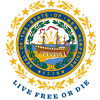Sudden Unexpected Infant Death
Sudden Unexpected Infant Death
In 2015, there were about 3,700 Sudden unexpected infant deaths (SUID) in the United States. These deaths occur among infants less than 1 year old and have no immediately obvious cause.
The three commonly reported types of SUID include the following:
- SIDS,
- Unknown cause, and
- Accidental suffocation and strangulation in bed.
In 2015, there were about 1,600 deaths due to SIDS, 1,200 deaths due to unknown causes, and about 900 deaths due to accidental suffocation and strangulation in bed.
Sudden Infant Death Syndrome (SIDS) is the sudden death of an infant that is unexplained after a complete investigation that includes an autopsy, a review of the death scene, and a review of the infant's recent history. Nationally, and in New Hampshire, SIDS is the leading cause of death in infants between one month and one year of age.
While no one knows for sure why SIDS happens, research suggests that some babies are born with brain abnormalities that make them vulnerable to sudden death. Research has shown many ways to lower the risk of SIDS such as putting a baby to sleep on its back every time in its own crib on a firm flat mattress without fluffy bedding, comforters, or pillows, and not smoking near the baby or when pregnant.
In New Hampshire, between 5 and 10 infants die from SIDS each year. Every baby who dies is surrounded by a network of family and caregivers. Grieving families have found that it is helpful to get information and support at this difficult and painful time.
What does the New Hampshire SIDS Program do?
- The Office of the Chief Medical Examiner calls the NH SIDS Program when an infant death occurs that may be due to SIDS.
- SIDS Program staff contact the family to answer questions, send information about SIDS and grief supports, and connect the family with another parent whose baby also died of SIDS.
- The SIDS Program provides information to anyone interested, and offers training to health professionals, child care personnel, and others involved with children and families on SIDS, reducing the risks, and promoting safe sleeping.
Video Resources
- Safe Infant Sleep for Grandparents and Other Trusted Caregivers (2 minutes)
- Safe Sleep for Infants: Kohl's Safe at Home Program and Children's Hospital at Dartmouth (1 minute)
- Safe Sleep for Your Baby (10 minutes)
- US Consumer Product Safety Commission "10 Tips to Keep Your Baby Safe" (5 minutes)
- US Consumer Product Safety Commission "Baby Safety, Back to Basics" (1 minute)
Resources for Parents
The Safe to Sleep® campaign offers videos in English and Spanish explaining ways to reduce the risk of SIDS and other sleep-related causes of infant death.
- 3 Key Ways Dads Can Help Baby Sleep Safe
- Accidental Suffocation and Strangulation During Infant Sleep Infographic
- Adult Bed Dangers
- Bare is Best Flyer
- Breast Care After Your Baby Dies
- How to Keep Your Sleeping Baby Safe
- Safe Sleep for Your Grandbaby
- SIDs by Age Infographic
- What Does a Safe Sleep Environment Look Like?
Publications
New Hampshire Public Health Issue Brief: Sleep-Related Infant Deaths, 2011-2018



